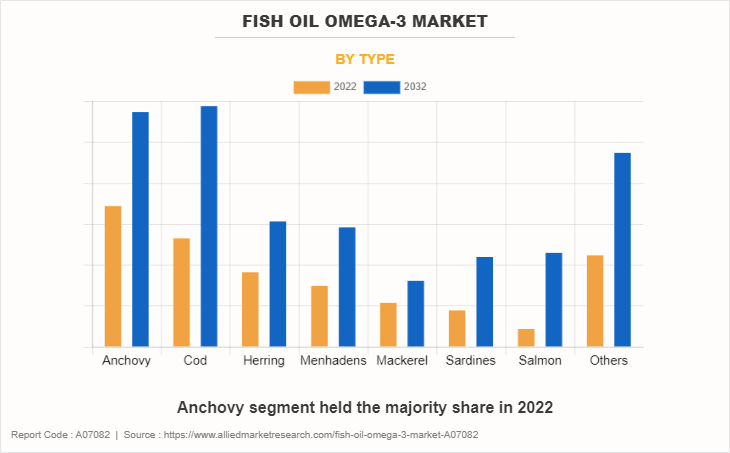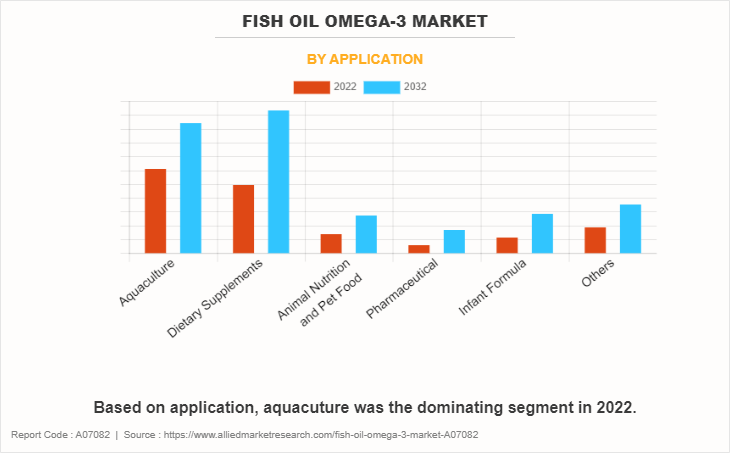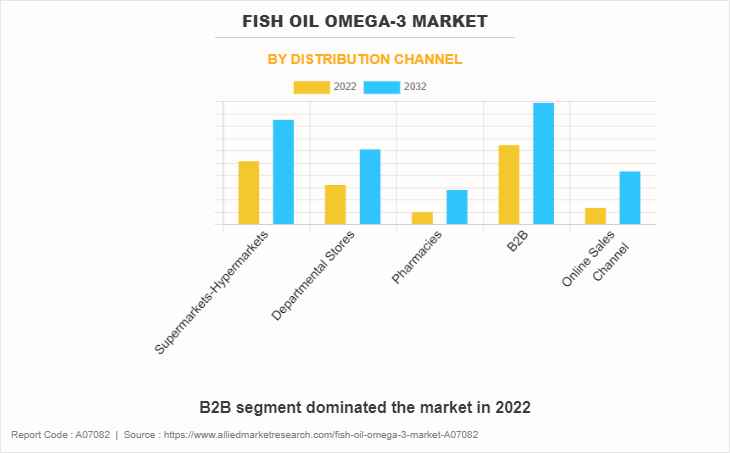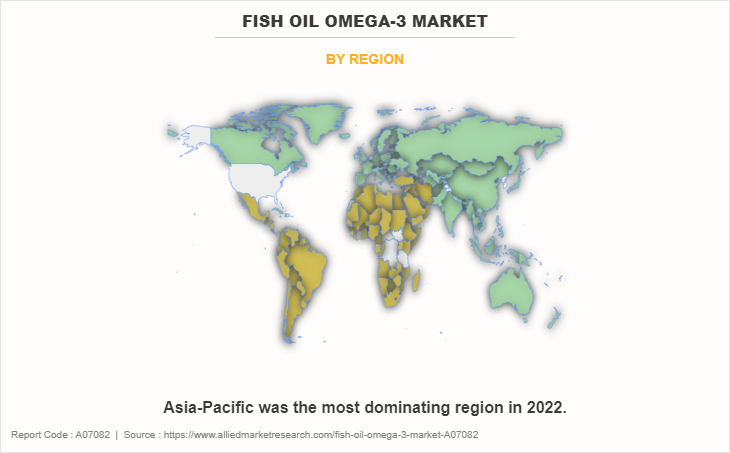Fish Oil Omega-3 Market Research, 2032
The global fish oil omega-3 market size was valued at $1.1 billion in 2022, and is projected to reach $1.8 billion by 2032, growing at a CAGR of 5.1% from 2023 to 2032.
The fish oil omega-3 market deals with sourcing, supplying, and distributing a diverse range of fish oil used in the production of omega-3 rich products such as dietary supplements, animal feel in aquaculture, infant formula, pharmaceuticals, and pet food. These fish oils are extracted from different types of fish starting from anchovy, cod, herring, menhadens, mackerel to various types of other fish high in omega-3 content. According to IFFO - The Marine Ingredients Organization, marine ingredients such as fish oil omega-3 serve as major components within the aquafeed sector, which accounts for 65-70% of the material usage, and are also utilized in the production of feed for pigs, poultry, and pets.

Key Market Dynamics
The rise in the number of aging populations globally, owing to improvements in healthcare and lifestyle changes, has led to the growth of the fish oil omega-3 market size. The World Health Organization (WHO) estimates that by 2030, over one-sixth of the global population will consist of individuals aged sixty and older. It is also anticipated that the number of people aged 80 and above will triple, reaching approximately 426 million by the year 2050. As a result, there is an increased chance of age-related diseases such as cardiovascular disorders, joint problems, and cognitive decline in the elderly population. Fish oil omega-3 has been proven to address many health issues, including the prevention of cardiovascular disorders, improvement in brain function, and reduced inflammation in older individuals, which are frequent in aged individuals. So, products and supplements derived from fish oil omega-3 have made it a convenient solution for individuals in the elderly age group those seek natural remedies and supplements to deal with various health problems. Furthermore, fish oil omega-3 has gained attention for its potential role in prevention and treatment of sarcopenia, a condition characterized by muscle loss in elderly individuals. Healthcare professionals may increasingly recommend fish oil to elderly patients, which is likely driving demand for fish oil omega-3 in pharmaceutical and nutraceutical sectors.
The market also faces certain challenges which may hamper the growth of fish oil omega-3 for the next few years. Stringent government policies regarding fish oil products can potentially act as a restraint on the growth of the fish oil omega-3 market. These stringent regulations encompass monitoring the production, packaging, and labeling processes to ensure that consumers receive what is accurately stated on the product labels, which could potentially hinder market expansion. For instance, the Codex Standard for Named Oils (Codex Stan 329-2017) outlines guidelines for the physical and chemical characteristics of these oils, including parameters such as acidity, peroxide value, iodine value, and fatty acid composition. It also sets maximum limits for contaminants, including heavy metals and environmental pollutants. In addition, Codex Guidelines on Nutrition Labeling offer recommendations for labeling fish oil products, which must provide information on nutritional content, serving sizes, and health claims.
However, adherence to these rigorous government regulations often necessitates high investments in testing, quality control, and documentation, which may result in increased production costs for fish oil omega-3 products. An increase in the prices of basic products such as fish oil omega-3 may ultimately lead to higher prices for final products made using these oils. This price hike might have significant implications for industries dependent on fish oil, such as dietary supplements and aquaculture, as they would face increased production costs and potentially pass these expenses onto consumers. Additionally, other businesses procuring fish oil for various applications may also experience financial challenges owing to rising costs, potentially affecting their profit margins and competitiveness in the market. These high regulatory barriers may also create hurdles for new entrants seeking to enter the market, which could slow down innovation and competition in the fish oil omega-3 sector, ultimately limiting the market growth. Moreover, stringent regulations may impact international trade in fish oil omega-3 products, potentially imposing export restrictions or import barriers, which may hinder the overall fish oil omega-3 market growth.
The increased focus on research and development of omega-3 fish oil products, along with the introduction of various formulations such as powders, gummies, and chewable, provides significant opportunities for the growth of the fish oil omega-3 market. The diversification of product offerings through these innovative formulations enables fish oil omega-3 manufacturers to expand their product portfolios. Moreover, by providing a wide range of product options, manufacturers can access new market segments and demographics that might have been less inclined to consume traditional fish oil capsules. This diversification has high potential to increase the market share and revenue for key players in the fish oil omega-3 market.
Furthermore, research and development efforts allow for the creation of specialized formulations, such as high-potency blends or tailored omega-3 fish oil products designed to address specific health needs. These customized offerings have the potential to tap into niche markets and meet the diverse requirements of consumers. Research-driven innovations may also result in formulations with improved bioavailability, ensuring which ensures that consumers receive the maximum benefits of omega-3 fatty acids. This helps to boost consumer trust and increase the perceived effectiveness of the products. The increased emphasis on research and development in omega-3 fish oil products and formulations brings numerous advantages to manufacturers, including market expansion, enhanced profitability, and a more robust brand presence in the fish oil omega-3 market. These benefits is expected to enable manufacturers to remain competitive and meet the evolving demands of consumers in the dynamic fish oil omega-3 market forecast.
Segmental Overview
The fish oil omega-3 market is analyzed on the basis of type, application, distribution channel, and region. By type, it is divided into anchovy, cod, herring, menhadens, mackerel, sardines, salmon, and others. As per application, it is categorized into aquaculture, dietary supplements, animal nutrition and pet food, pharmaceutical, infant formula, and others. Depending on distribution channel, it is fragmented into supermarkets-hypermarkets, departmental stores, pharmacies, B2B, and online sales channel. Region wise, fish oil omega-3 industry is analyzed across North America, Europe, Asia-Pacific, and LAMEA.
By Type
As per type, the anchovy segment dominated the fish oil omega-3 market share in 2022 and is anticipated to maintain its dominance throughout the forecast period. Anchovy fish oil is versatile in nature, which has led to its increased application in various industrial sectors such as ingredient in dietary supplements, functional foods, pharmaceuticals, and pet food products. It also plays a major role in aquaculture as a crucial component in fish and shrimp feed. The aquaculture industry relies on the nutritional benefits of anchovy fish oil to enhance the growth and health of farmed aquatic species. This diverse utilization allows it to penetrate multiple market segments and industries, which increases the overall market share of this segment.

By Application
By application, the aquaculture segment dominated the fish oil omega-3 market share in 2022 and is anticipated to maintain its dominance throughout the forecast period. The rapid growth of aquaculture, the fastest-expanding food production sector, is driving an increased demand for fish feed. Fish oil, rich in omega-3 fatty acids crucial for fish health and growth, is a vital ingredient in many feed formulations. As per the FAO's 2022 State of Fisheries and Aquaculture (SOFIA) report, fishmeal and fish oil are known as the most nourishing and readily digestible elements within the diet of farmed fish. Moreover, concerns about the sustainability of wild-caught fish populations have further increased the demand for farmed fish as a more sustainable omega-3 source.

By Distribution Channel
Depending on distribution channel, the B2B segment dominated the fish oil omega-3 market in 2022 and is anticipated to maintain its dominance throughout the forecast period. The B2B fish oil omega-3 ecosystem is comprised of multiple players, including manufacturers/suppliers, wholesalers/distributors, retailers, food service providers, food manufacturers, importers, and exporters. It consists of marketplaces where the vendor and the buyer of fish oil omega-3 make deals and transactions. The suppliers provide fish oil omega-3 directly from other businesses and go through a process where one business makes a transaction with another. Moreover, the B2B distribution channel does not involve any intermediaries and has smooth monetary transactions. The B2B e-commerce evolution has introduced the path to digital procurement in the frozen seafood industry. The adoption of digitalization in sales channels has made the work of manufacturers and vendors easy & smooth. In addition, the manufacturers display their products directly through digital marketing platforms such as Facebook, Instagram, Twitter, and Google which has increased the demand for fish oil omega-3 product. Therefore, manufacturers are expected to expand their consumer base along with the improved perception of their brand.

By Region
Region wise, Asia-Pacific is predicted to dominate the market with the largest share during the forecast period (2023-2032). Asia-Pacific is characterized by largest global population, rising disposable income, changing consumer lifestyle, growing health consciousness, and rising application of fish oil omega-3 in the foods & beverages industry. Moreover, nations such as China and India are among the largest fish oil omega-3 producers across the globe. Huge production of fish species that are rich sources of fish oil omega-3 positively boosts growth of the fish oil omega-3 market demand in the region.

Competitive Landscape
The major players analyzed for the fish oil omega-3 industry include Barlean's Organic Oils, L.L.C., Omega Protein Corporation, Carlson Laboratories, Inc., Olvea Fish Oils, Colpex International S.A.C, Nordic Naturals, Inc., Stepan Company, PELAGIA AS, Koninklijke DSM N.V., and GC Rieber VivoMega AS.
Manufacturers of fish oil omega-3 are creating new products and formulae to meet the change in requirements of their customers. They make investments in R&D to create novel combinations of fish oils with enhanced functionality, stability, and selectivity and create new applications for existing fish oil omega-3. While developing new products, enhancing production methods, and navigating regulatory requirements, manufacturers of fish oil omega-3 frequently work with fisheries, regulatory organizations, and other industry players. Manufacturers can increase their capacities, pool their knowledge, and create novel solutions through these collaborations. Manufacturers are improving their production capacity and cutting costs, which can involve both investing in new production facilities and renovating current ones to keep up with the rising demand for fish oil omega-3.
The market for fish oil omega-3 is anticipated to expand due to rise in omega-3 dietary supplement products, public knowledge of the advantages of omega-3 fatty acids for health, and development of new and effective fish oil omega-3. In addition, factors such as innovation, collaboration, product launch, and expansion are opportunistic for fish oil omega-3 market growth.
Key Benefits for Stakeholders
- This report provides a quantitative analysis of the market segments, current trends, estimations, and dynamics of the fish oil omega-3 market analysis from 2022 to 2032 to identify the prevailing fish oil omega-3 market opportunities.
- The market research is offered along with information related to key drivers, restraints, and opportunities.
- Porter's five forces analysis highlights the potency of buyers and suppliers to enable stakeholders make profit-oriented business decisions and strengthen their supplier-buyer network.
- In-depth analysis of the fish oil omega-3 market segmentation assists to determine the prevailing market opportunities.
- Major countries in each region are mapped according to their revenue contribution to the global market.
- Market player positioning facilitates benchmarking and provides a clear understanding of the present position of the market players.
- The report includes the analysis of the regional as well as global fish oil omega-3 market trends, key players, market segments, application areas, and market growth strategies.
Fish Oil Omega-3 Market Report Highlights
| Aspects | Details |
| Market Size By 2032 | USD 1.8 billion |
| Growth Rate | CAGR of 5.1% |
| Forecast period | 2022 - 2032 |
| Report Pages | 298 |
| By Type |
|
| By Application |
|
| By Distribution Channel |
|
| By Region |
|
| Key Market Players | Pelagia AS, Omega Protein Corporation, Carlson Laboratories, Inc., GC Rieber VivoMega, Olvea Fish Oils, Stepan Company, Barlean's Organic Oils, LLC, Nordic Naturals, Koninklijke DSM N.V., Colpex International S.A.C |
Analyst Review
On the basis of insights of top CXOs, the fish oil omega-3 market is expected to grow rapidly in the future, owing to growing demand for dietary supplements among the global population. Rise in number of working women, increasing workload, and busy & hectic lifestyle of consumers propel the demand for omega-3 fish oil dietary supplements across the globe.
Moreover, people prefer fish oil omega-3 to meet their daily omega-3 fatty acid requirements. Growth in awareness regarding consumption of fish oil omega-3 among the global population is exponentially contributing toward the growth of the global fish oil omega-3 market. The CXOs further added that Asia-Pacific is expected to be significant contributor toward the growth of the fish oil omega-3 market during the forecast period.
One of the most significant impacts on the fish oil omega-3 market was the surge in demand for healthier and functional food products during the pandemic. Consumers increasingly sought products with added nutritional benefits, and fish oil omega-3 's reputation as a natural and clean label ingredient is expected to position it favorably in this context. Manufacturers have invested highly in to find the possible ways of incorporation of fish oils in wide range of food and beverage products, which is expected to cope with the rise in demand for healthier options. Furthermore, the pandemic-driven trend of preventive health care among consumers has boosted the retail sales of fish oil omega-3-based products.
The global fish oil omega-3 market size was valued at $1.1 billion in 2022, and is projected to reach $1.8 billion by 2032
The global Fish Oil Omega-3 market is projected to grow at a compound annual growth rate of 5.1% from 2023 to 2032 $1.8 billion by 2032
The major players analyzed for the fish oil omega-3 industry include Barlean's Organic Oils, L.L.C., Omega Protein Corporation, Carlson Laboratories, Inc., Olvea Fish Oils, Colpex International S.A.C, Nordic Naturals, Inc., Stepan Company, PELAGIA AS, Koninklijke DSM N.V., and GC Rieber VivoMega AS.
Region wise, Asia-Pacific is predicted to dominate the market with the largest share during the forecast period (2023-2032).
Increase in aging population, Surge in demand for dietary supplement, Rise in demand from aquaculture industry
Loading Table Of Content...
Loading Research Methodology...


